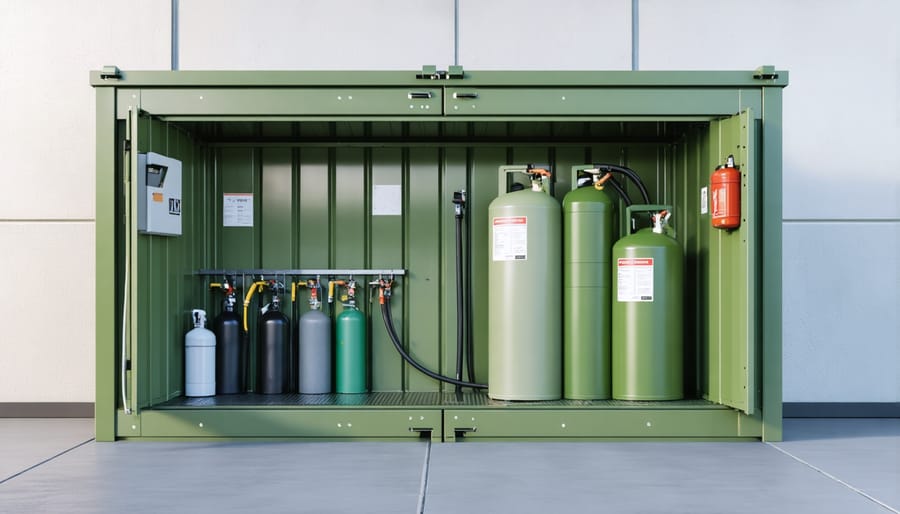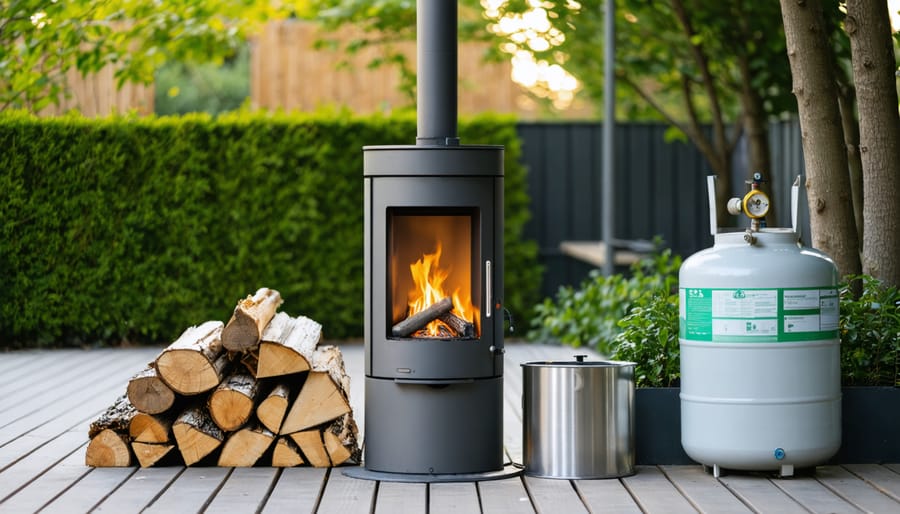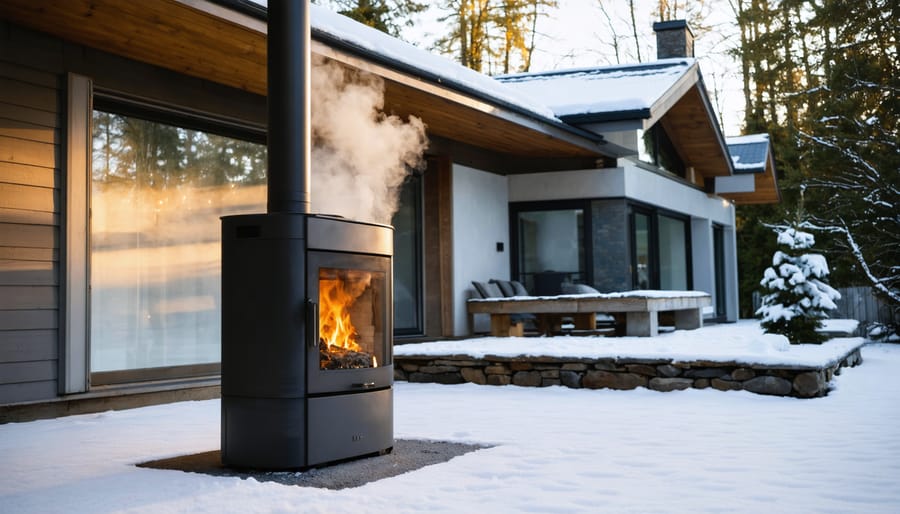Choosing the right heating fuel transforms your outdoor living space while keeping your family warm and your energy costs manageable. From traditional firewood to modern propane systems, each fuel type offers unique advantages for home heating. Following proper outdoor heating safety precautions ensures optimal performance while protecting your investment. Whether you’re looking to heat a cozy patio or power a whole-house heating system, understanding the efficiency, environmental impact, and cost-effectiveness of different fuel options helps you make an informed decision that aligns with both your comfort needs and environmental values. Today’s heating fuel choices extend beyond traditional options, incorporating renewable resources and high-efficiency alternatives that provide sustainable warmth while reducing your carbon footprint.
Common Fuel Options for Outdoor Heating
Propane: The Popular Choice
Propane stands out as a versatile and efficient heating fuel choice for modern homes. This clean-burning fuel delivers consistent, powerful heat while producing minimal emissions compared to other fossil fuels. Widely available across the country, propane can be easily stored in tanks of various sizes to suit your specific needs. Homeowners appreciate its convenience – there’s no need to handle messy wood or deal with ash cleanup. With automatic delivery options from local suppliers, you’ll never have to worry about running out of fuel during cold spells. While initial setup costs may be higher due to tank installation, propane’s excellent heat output and energy efficiency often result in lower long-term heating costs. Plus, its reliable performance in any weather makes it particularly appealing for primary heating systems and outdoor heating solutions.
Natural Gas: Connected Convenience
Natural gas heating offers unparalleled convenience with its always-ready, continuous fuel supply directly to your home. Once installed, you’ll never need to worry about running out of fuel or scheduling deliveries. The consistent flame and precise temperature control make it an attractive option for homeowners seeking reliable heat.
Installation requires professional setup and connection to municipal gas lines, which may not be available in all areas. While initial installation costs can be higher, natural gas typically proves more economical in the long run due to lower fuel costs. It’s also one of the cleanest-burning fossil fuels, producing fewer emissions compared to other heating options.
The system’s efficiency and minimal maintenance requirements make it particularly appealing for busy households. Just remember that professional annual inspections are essential for safety and optimal performance.
Electric Options: Clean and Simple
Electric heating options offer a clean, efficient alternative to traditional fuel sources. With no combustion involved, these systems eliminate concerns about emissions, ventilation, or fuel storage. Modern electric heaters come in various styles, from sleek wall-mounted panels to realistic flame-effect fireplaces that provide ambiance without the maintenance of real fires.
The simplicity of electric heating is one of its biggest draws – just plug in and enjoy instant warmth. Many units feature precise temperature controls and programmable settings, allowing you to optimize your home’s comfort while managing energy costs. While electricity rates vary by region, the lack of maintenance costs and the improving efficiency of modern units make electric heating an increasingly attractive option for eco-conscious homeowners.
Plus, as the grid becomes greener with more renewable energy sources, electric heating becomes an even more environmentally responsible choice.
Safety Considerations for Each Fuel Type

Storage and Handling Guidelines
Proper fuel storage is crucial for both safety and efficiency. For firewood, maintain a dedicated storage area that’s elevated, covered, and well-ventilated to prevent moisture accumulation. Stack wood at least 6 inches off the ground and keep it away from your home’s exterior walls to discourage pests. Following safety guidelines for outdoor heating ensures optimal fuel performance while protecting your property.
For propane tanks, store them upright in a cool, dry location away from direct sunlight and heat sources. Never store propane indoors or in enclosed spaces like basements. Keep tanks at least 10 feet away from potential ignition sources and ensure proper ventilation.
Pellet fuel requires special attention to moisture control. Store pellets in their original packaging or sealed containers in a dry area. Avoid storing directly on concrete floors, as they can draw moisture through the material. For optimal preservation, maintain storage temperatures between 40-90°F.
When handling any heating fuel, wear appropriate protective gear such as gloves and safety glasses. Always use proper lifting techniques when moving heavy loads of firewood or fuel containers. Keep children and pets away from fuel storage areas, and clearly mark these spaces with appropriate warning signs. Remember to regularly inspect your storage area for signs of moisture damage, pest infestation, or container deterioration.
Emergency Procedures and Safety Equipment
Safety should always be your top priority when dealing with heating fuels. Keep a properly rated fire extinguisher within easy reach of your heating appliance, and ensure everyone in your household knows its location and operation. Install carbon monoxide detectors on every floor, particularly near sleeping areas, as this odorless gas can be deadly.
Create an emergency evacuation plan and share it with all family members. Keep emergency contact numbers, including your local fire department and fuel supplier, posted in a visible location. If you smell gas or suspect a leak, evacuate immediately and call emergency services from a safe distance.
For solid fuels like wood or pellets, maintain proper ventilation and regularly check for creosote buildup. Just as proper maintenance of outdoor heaters is crucial, indoor heating systems require regular inspection and cleaning to prevent hazardous conditions.
Store fuel properly in designated containers away from living spaces. For liquid fuels, use only approved safety containers and keep them in a well-ventilated area. Never store gasoline or other highly flammable materials near heat sources. Keep a first aid kit nearby and familiarize yourself with basic burn treatment procedures.
In case of a fuel-related fire, never use water on oil or electrical fires. Instead, use your fire extinguisher and call emergency services immediately. Regular maintenance and vigilance are your best defenses against heating-related emergencies.
Eco-Friendly Considerations
Carbon Footprint Comparison
When it comes to environmental impact, different heating fuels leave distinctly different carbon footprints. Natural gas is often considered one of the cleaner-burning fossil fuels, producing about 40% less carbon dioxide than coal and 20% less than heating oil. Propane, while still a fossil fuel, burns even cleaner than natural gas and produces minimal emissions when properly combusted.
Wood, though traditionally viewed as carbon-intensive, can actually be carbon-neutral when sourced sustainably. Trees absorb carbon dioxide during their lifetime, and when burned, they release only what they’ve stored. However, this balance depends greatly on responsible forestry practices and efficient burning methods.
Pellets made from compressed sawdust and wood waste offer an environmentally conscious choice, as they repurpose materials that might otherwise go to waste. Electric heating’s carbon footprint varies significantly depending on your power source – it’s particularly green when powered by renewable energy like solar or wind.
Bio-ethanol stands out as one of the most environmentally friendly options, producing minimal emissions and requiring no chimney or flue. Its production from renewable resources makes it a sustainable choice for eco-conscious homeowners.

Sustainable Alternatives
As homeowners increasingly prioritize environmental responsibility, several sustainable heating alternatives have emerged. Biomass pellets, made from compressed wood waste and agricultural byproducts, offer a renewable option that produces minimal carbon emissions. These pellets burn efficiently and can be used in specially designed stoves or furnaces.
Another promising alternative is bioethanol, a clean-burning fuel derived from plant materials. It produces no smoke or harmful emissions, making it ideal for both indoor and outdoor heating. Modern bioethanol fireplaces combine eco-friendly operation with stylish design, perfect for environmentally conscious homeowners.
Solar thermal heating systems, while requiring initial investment, provide a completely renewable heating solution. These systems capture solar energy and convert it into heat, which can be stored for use during colder periods. When combined with proper insulation and smart home technology, solar heating can significantly reduce your carbon footprint.
For those seeking a hybrid approach, dual-fuel systems allow you to switch between traditional and sustainable fuel sources based on availability and seasonal needs, offering both environmental benefits and practical flexibility.
Cost Analysis and Efficiency
Long-Term Cost Comparison
When comparing long-term heating costs, natural gas typically emerges as the most economical option, with average annual costs ranging from $500-800 for a typical home. Propane follows as a mid-range choice, usually costing $1,200-1,800 annually. Electric heating often proves the most expensive, potentially reaching $1,800-2,500 per year depending on local utility rates.
Wood and pellets offer interesting cost dynamics. While firewood can be very economical if you have access to free or low-cost sources (potentially as low as $200-400 annually), purchased firewood typically costs $800-1,200 per season. Pellets fall in the middle range at $900-1,400 annually.
Remember that these figures can vary significantly based on your location, home size, and local fuel prices. Installation costs also play a crucial role – gas systems require professional installation and maintenance, while wood stoves need regular chimney cleaning. Consider both upfront and operating costs when making your decision.
Heating Efficiency Ratings
Understanding heating efficiency helps you make the most of your fuel investment. Natural gas typically leads the pack with efficiency ratings of 85-97%, making it a top choice for consistent heating. Propane follows closely behind at 80-95% efficiency, offering similar performance to natural gas with the added benefit of portability.
Wood, while traditionally popular, varies significantly in efficiency. Modern wood stoves can achieve 70-85% efficiency, though traditional fireplaces may only reach 20-30%. Pellet stoves bridge this gap with impressive 70-83% efficiency rates, offering a more consistent burn than traditional wood.
Electric heating boasts nearly 100% efficiency at the point of use, though the overall efficiency depends on how your electricity is generated. When comparing BTU (British Thermal Unit) output, natural gas and propane deliver the most heat per unit, while wood and pellets offer a middle-ground solution balancing efficiency with environmental considerations.
Choose your fuel type based on both efficiency ratings and your specific heating needs to ensure optimal performance and cost-effectiveness.
Choosing the right heating fuel for your home involves careful consideration of multiple factors, from cost-effectiveness to environmental impact. Whether you opt for traditional wood, convenient natural gas, efficient pellets, or clean-burning bioethanol, each fuel type offers unique advantages to suit different lifestyle needs. Remember to prioritize both safety and efficiency when making your selection, and consider the long-term implications of your choice, including maintenance requirements and environmental footprint. For the most sustainable heating solution, consider combining multiple fuel types or incorporating renewable options into your heating strategy. By weighing these factors against your specific needs, budget, and environmental goals, you can create a comfortable and efficient heating system that serves your home for years to come.






